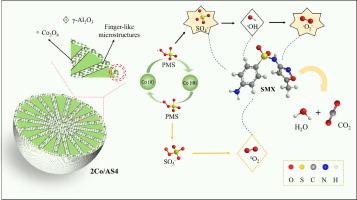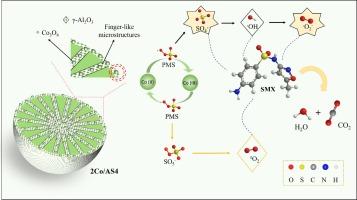用于微米级工艺强化的创新微通道结构珠:用于消除磺胺甲恶唑的水处理案例研究
IF 13.2
1区 工程技术
Q1 ENGINEERING, CHEMICAL
引用次数: 0
摘要
本研究的重点是开发创新的微通道结构珠,旨在彻底改变多孔材料内部的扩散传质。具体来说,我们创造了微通道结构的氧化铝珠(as0,3 毫米直径),使用相转化和烧结相结合的工艺。随后,通过溶胶-凝胶工艺首次加入了不同数量的介孔γ-Al2O3相,以提高AS0珠的内比表面积(SBET),并通过浸渍(2Co/ASx)应用了2 wt%的钴催化相。将钴-γ-Al2O3整合到珠内的第二种方法是一步共浸渍过程(2Co/ASx (co-imp.), x的范围从0到4与不同数量的γ-Al2O3溶胶)。然后在过氧单硫酸盐(PMS)激活的AOPs体系中,在温和的反应条件下对这些样品进行磺胺甲恶唑(SMX)的降解。实验结果表明,具有较高SBET的微通道结构微球具有更强的催化活性,其中2Co/ASx (co-imp.)比2Co/ASx具有更好的催化效率。这种改善是由于珠上暴露的开放表面孔更大,这有助于反应物和产物的扩散传质。然而,过量的γ-Al2O3会降低表面孔隙的可达性,增加高污染物浓度(40 mg/L SMX)下的传质阻力,从而降低SMX的去除效率。更重要的是,意想不到的是,再生后的催化剂表现出更高的性能,在20 min内达到96.32% %的SMX去除率,而新鲜催化剂在120 min内达到95.75% %。这是由于再生过程中球团表面开放孔的可及性增强,强调了加强扩散转移过程对催化反应的重要性。这样的好处是高度转移到更广泛的多相催化应用。本文章由计算机程序翻译,如有差异,请以英文原文为准。


Innovative microchannel-structured beads for microscale process intensification: A case study on water treatment for sulfamethoxazole abatement
This study focuses on the development of innovative microchannel-structured beads, designed to revolutionize diffusional mass transfer inside porous materials. Specifically, we created microchannel-structured alumina beads (AS0, 3 mm in diameter), using a combined phase-inversion and sintering process. This was followed by incorporating varying amounts of mesoporous γ-Al2O3 phase through a sol–gel process for the first time to enhance the internal specific surface area (SBET) of the AS0 beads, along with a 2 wt% cobalt catalytic phase applied via impregnation (2Co/ASx). A second approach for integrating cobalt-γ-Al2O3 inside the beads is a one-step co-impregnation process (2Co/ASx (co-imp.), x ranges from 0 to 4 with varying amounts of γ-Al2O3 sols). These samples were then subjected to the degradation of sulfamethoxazole (SMX) in the peroxymonosulfate (PMS)-activated AOPs system under mild reaction conditions. Experimental results demonstrated that the microchannel-structured beads with higher SBET displayed enhanced catalytic activity, with 2Co/ASx (co-imp.) achieving better catalytic efficiency compared to 2Co/ASx. This improvement was attributed to larger exposed open surface pores on the beads, which facilitated diffusional mass transfer of reactants and products. However, overloading γ-Al2O3 could reduce the accessibility of surface pores, increase mass transfer resistance at high pollutant concentrations (40 mg/L SMX), and consequently reduce SMX removal efficiency. More importantly, it is unexpected that the catalyst exhibited substantially higher performance after regeneration, achieving 96.32 % SMX removal in 20 min, compared to 95.75 % in 120 min for the fresh catalyst. This was attributed to the enhanced accessibility of open pores on the bead surface during regeneration, highlighting the significance of intensifying the diffusional transfer process to benefit catalytic reactions. Such benefits are highly transferable to a broader spectrum of heterogeneous catalysis applications.
求助全文
通过发布文献求助,成功后即可免费获取论文全文。
去求助
来源期刊

Chemical Engineering Journal
工程技术-工程:化工
CiteScore
21.70
自引率
9.30%
发文量
6781
审稿时长
2.4 months
期刊介绍:
The Chemical Engineering Journal is an international research journal that invites contributions of original and novel fundamental research. It aims to provide an international platform for presenting original fundamental research, interpretative reviews, and discussions on new developments in chemical engineering. The journal welcomes papers that describe novel theory and its practical application, as well as those that demonstrate the transfer of techniques from other disciplines. It also welcomes reports on carefully conducted experimental work that is soundly interpreted. The main focus of the journal is on original and rigorous research results that have broad significance. The Catalysis section within the Chemical Engineering Journal focuses specifically on Experimental and Theoretical studies in the fields of heterogeneous catalysis, molecular catalysis, and biocatalysis. These studies have industrial impact on various sectors such as chemicals, energy, materials, foods, healthcare, and environmental protection.
 求助内容:
求助内容: 应助结果提醒方式:
应助结果提醒方式:


